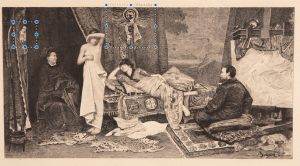Havelock Ellis’ first volume of Studies in the Psychologies of Sex (1897) closely examines a number of ideas and issues surrounding queer topics. Ellis was a writer, and a doctor, thus where his interest in the body, and sexuality comes into play. His work acknowledges the absurdity of certain ideas or theories that may have previously been believed. In his preface, Ellis states, “Sex lies at the root of life, and we can never learn to reverence life until we know how to understand sex. —So, it seems to me” (X). His work is not just an examination of sex, and other pertaining topics; it is also an attempt to further understand human existence as a whole.
The section that I am focusing on is titled, ‘The Theory of Sexual Inversion.’ This work gives a queer reading of the Victorian era as it allows a current-day reader to see how people of different socioeconomic classes viewed sexual inversion and other non-heteronormative tendencies. This specific excerpt also considers the characteristics of one’s sexuality and how these characteristics come about or if they come about, as the argument that one’s sexual orientation is congenital is approached as well. There is a contrast in the second and third lines, Ellis writes, “Is it [sexual inversion], as many would have us believe, an abominably acquired vice, to be stamped out by the prison? or is it, as a few assert, a beneficial variety of human emotion which should be tolerated or even fostered?” (129). The words ‘many’ and ‘few’ clarify that the more popular belief is also the more negative one. Ellis acknowledges that there are reasonable truths in both sides of the argument, ‘is sexual inversion congenital or not?’ He determines that ultimately, one cannot argue that sexual inversion is acquired without counteracting his or her own point— therefore, the only valid argument is that sexual inversion is congenital. The progressiveness of this argument is made evident in the beginning with the word ‘few’ being attributed to this opinion, and to the opinion that sexual inversion should be accepted.
Ellis states those who wish to “enlarge the sphere of the congenital [opinion]” include “Krafft-Ebing, Moll, Féré” but also “today the majority of authorities” (130). At first glance, this seems to negate my original point of ‘few;’ however, I believe the key word in this line is ‘authorities.’ A question is, who is authorities ascribed to? The answer to this question exposes more about how Ellis’ work gives a queer, or non-heteronormative view of the Victorian Era. Those who have authority are most likely educated to some extent. Though in 1880 an education act made school attendance mandatory for children of any economic standing, this law was not followed and only about 80% of children were attending school. This 80% were mostly from the higher class. However, the majority of adults there, at the time, are not or were not educated, making the authority figures, those who are educated, and of higher social and economic standing, the minority, or the ‘few.’
Ellis’ work gives a queer point of view on the Victorian era by allowing one to see the perspectives that many people of different backgrounds possess on the topic of sexual inversion.
Link to the uploaded work on the VQA: http://vqa.dickinson.edu/essay/studies-psychology-sex
Consulted information on education can be found here:
And here:
http://www.victorianchildren.org/victorian-schools/
Citation of Havelock Ellis’ work: Ellis, Havelock. “The Theory of Sexual Inversion.” Studies in the Psychologies of Sex, vol. 1, London, The University Press, 1897, pp. 129-30. 6 vols.
